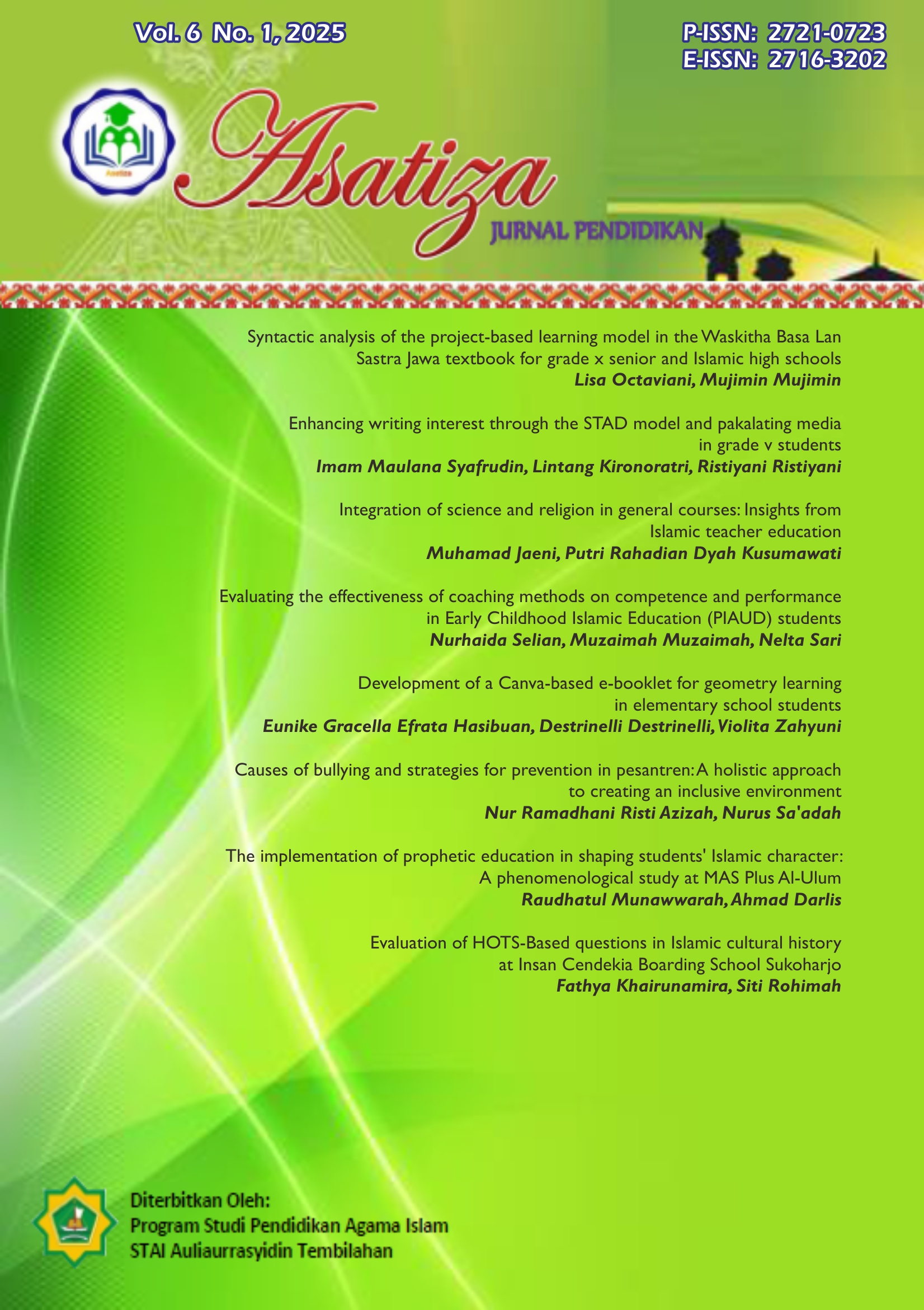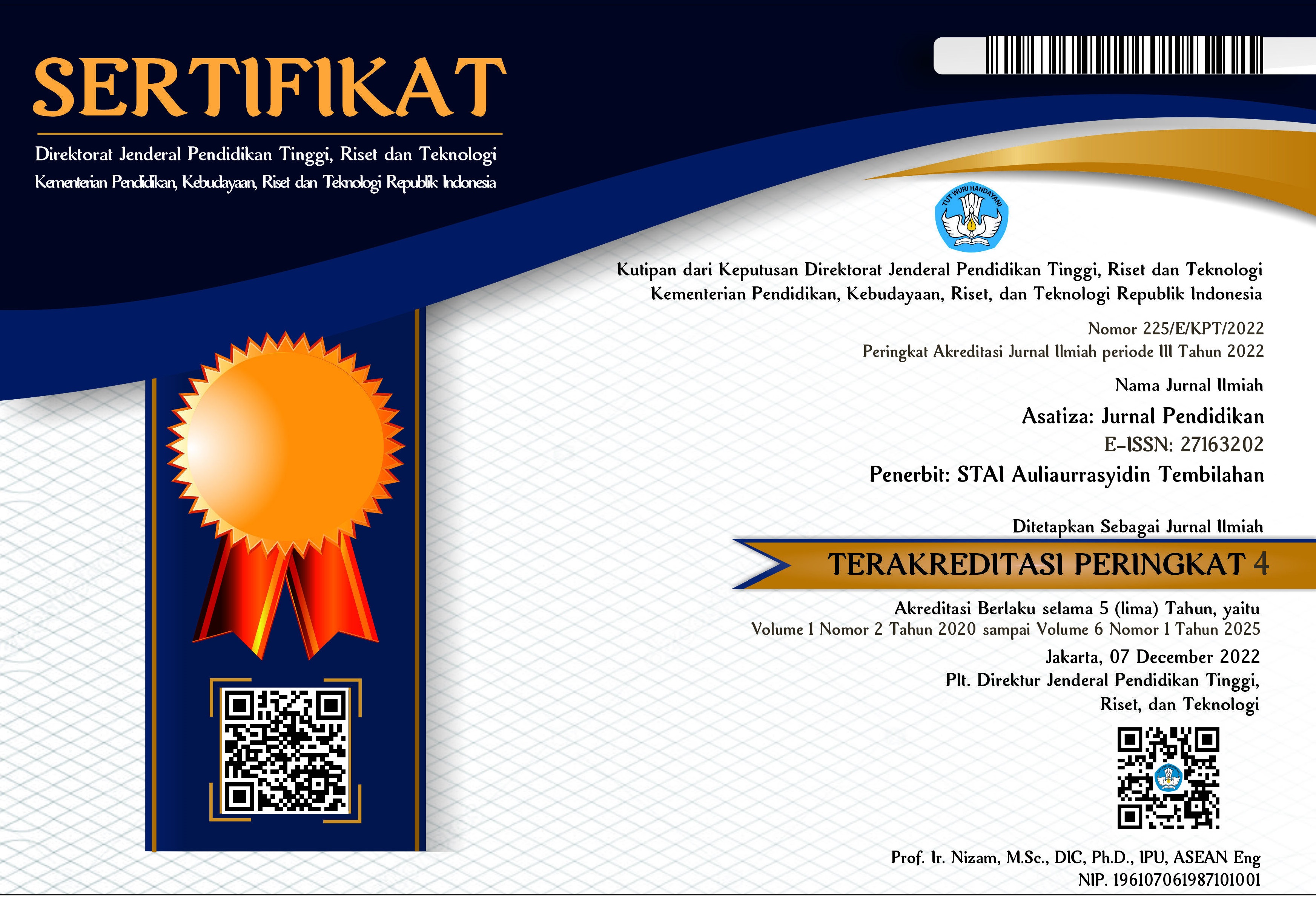Development of a Canva-based e-booklet for geometry learning in elementary school students
DOI:
https://doi.org/10.46963/asatiza.v6i1.2579Keywords:
Canva, E-Booklet, Geometry, Learning MediaAbstract
This study aims to develop an e-booklet as an instructional medium designed using Canva to enhance elementary school students’ understanding of geometric elements. The e-booklet facilitates visualization and spatial comprehension of geometric concepts, such as points, lines, and three-dimensional shapes, which students often find challenging to grasp. The study employed a Research and Development (R&D) approach using the ADDIE model, encompassing the stages of analysis, design, development, implementation, and evaluation. Validation was conducted by subject matter, media, and language experts, and the e-booklet was tested on small and large groups. The validation results indicated high levels of validity, with average scores of 4.7 for content, 4.8 for media, and 4.8 for language. Practicality was also rated highly, with an average score of 5 based on teachers’ evaluations and positive feedback from students, demonstrating improved understanding of geometric concepts. The e-booklet effectively delivers geometric concepts visually and interactively, serving as an alternative and effective learning medium. This study concludes that the Canva-based e-booklet can create an engaging learning environment and support teachers in the instructional process. Further development is recommended to enhance its effectiveness in teaching other mathematical topics.
Downloads
References
Changwong, K., Sukkamart, A., & Sisan, B. (2018). Critical thinking skill development: Analysis of a new learning management model for Thai high schools. Journal of International Studies, 11(2), 37-48. http://dx.doi.org/10.14254/2071-8330.2018/11-2/3
Coşkun Çelik, H., & Özdemir, F. (2020). Mathematical Thinking as a Predictor of Critical Thinking Dispositions of Pre-service Mathematics Teachers. International Journal of Progressive Education, 16(4), 81-95. https://doi.org/10.29329/ijpe.2020.268.6
Eymur, G., & Geban, Ö. (2017). The collaboration of cooperative learning and conceptual change: Enhancing the students’ understanding of chemical bonding concepts. International Journal of Science and Mathematics Education, 15(5), 853-871. https://doi.org/10.1007/s10763-016-9716-z
Farahita, S. D., dkk. (2024). Meningkatkan Keterlibatan Siswa Melalui Media Pembelajaran Berbasis Interactive Video Lesson. Cendikia: Jurnal Pendidikan dan Pengajaran, 2(11), 588-592. https://jurnal.kolibi.org/index.php/cendikia/article/view/4105
Ghazali, N. H. C., & Zakaria, E. (2011). Students' Procedural and Conceptual Understanding of Mathematics. Australian Journal of Basic and Applied Sciences, 5(7), 684-691. https://www.ajbasweb.com/old/ajbas/2011/July-2011/684-691.pdf
Haptanti, F. S., Hikmah, M., & Basuki, I. A. (2024). Peran Media Pembelajaran Dalam Pendidikan Bahasa Indonesia. Journal of Language, Literature, and Arts, 4(9), 972-980. https://journal3.um.ac.id/index.php/fs/article/view/6055
Kalyani, L. K. (2024). The Role of Technology in Education: Enhancing Learning Outcomes and 21st Century Skills. International Journal of Scientific Research in Modern Science and Technology, 3(4), 05-10. https://doi.org/10.59828/ijsrmst.v3i4.199
Kurniasih, E., Leksono, I., & Rohman, U. (2023). Development of Canva-Based Learning Media for 11 Grades of SMAN 3 Lamongan on Physics Material. Jurnal Teknologi Pendidikan: Jurnal Penelitian dan Pengembangan Pembelajaran, 8(3), 654-661. DOI: https://doi.org/10.33394/jtp.v8i3.7921
Lestari, N. G. A. M. Y., Boeriswati, E., & Djalil, N. D. (2024). Using Interactive Multimedia to Stimulate Early Childhood Students’ Speaking Skills: A Systematic Review. International Journal of Interactive Mobile Technologies, 18(16), 174-196. DOI: https://doi.org/10.3991/ijim.v18i16.47583
Munandar, D. R., Effendi, K. N. S., & Cahani, K. (2021). Kemampuan Pemahaman Konsep Matematika Siswa Ditinjau Dari Konsentrasi Belajar Pada Materi Statistika Dasar. Jurnal Pembelajaran Matematika Inovatif, 4(1), 215-224. DOI: https://doi.org/10.22460/jpmi.v4i1.p%25p
Mustofa, H.K. dan Kurniawan, A. (2020). Pengembangan Bola Banel Sebagai Media Pembelajaran Bola Voli Di SDN 1 Buluagung. Jurnal Kejaora: Jurnal Kesehatan Jasmani dan Olah Raga, 5(1), 1-5. DOI: https://doi.org/10.36526/kejaora.v5i1.763
Prayitno, dkk. (2022). Pengembangan Media Pembelajaran E-learning Berbasis Blogspot untuk Pembelajaran Mandiri Siswa pada Materi Koordinat Kartesius Kelas VIII SMP Negeri 1 Pringgasela. Journal of Classroom Action Research, 4(4), 212-220. DOI: https://doi.org/10.29303/jcar.v4i4.2512
Rahmawati, R. dkk. (2023). Pengembangan Media Pembelajaran Digital Flipbook Menggunakan Aplikasi Canva Dalam Pembelajaran Tematik Kelas V Sekolah Dasar. Jurnal Pendidikan Dasar Perkhasa, 9(2), 337-350. DOI: https://doi.org/10.31932/jpdp.v9i2.2259
Rahmi, A. N. (2023). Pengembangan Media Pembelajaran Interaktif Untuk Meningkatkan Pemahaman Siswa Pada Materi Pembagian untuk Siswa Kelas III SD. DWIJA CENDEKIA: Jurnal Riset Pedagogik, 7(1), 266-275. DOI: https://doi.org/10.20961/jdc.v7i1.71702
Ramdhani, S., Prastiti, T. D., & Paillin, B. (2024). Pengembangkan Keterampilan Berpikir Kritis dan Solusi Masalah Matematika Melalui Problem Based Learning. Jurnal Cendekia: Jurnal Pendidikan Matematika, 8(2), 1225-1242. DOI: https://doi.org/10.31004/cendekia.v8i2.3199
Sari, D. P., & Rosjanuardi, R. (2018). Errors of Students Learning with REACT Strategy in Solving the Problems of Mathematical Representation Ability. Journal of Mathematics Education Research, 7(1), 102-112. http://dx.doi.org/10.22342/jme.9.1.4378.121-128
Sari, F. A. (2024). Pentingnya Media Pembelajaran Dalam Sistem Pembelajaran. ENTINAS: Jurnal Pendidikan dan Teknologi Pembelajaran, 2(2), 414-421. https://entinas.joln.org/index.php/2023/article/download/100/128/205
Siagian, R. S. (2023). Pengembangan Media Pembelajaran Komik Menggunakan Aplikasi Canva For Education Pada Pembelajaran Matematika Kelas V Sekolah Dasar. Skripsi, Universitas Jambi.
Sinta, R., & Fanreza, R. (2024). Upaya Meningkatkan Motivasi Belajar Siswa melalui Media Digital Canva dalam Pembuatan Video Pembelajaran Ibadah Praktis pada Mata Pelajaran Fiqih di MTs Darul Ulum Budi Agung. Edulnovasi: Journal Of Basic Educational Studies, 4(2), 846-853. DOI: https://doi.org/10.47467/edu.v4i2.2239
Syahid, I. M., Istiqomah, N. A., & Azwary, K. (2024). Model Addie Dan Assure Dalam Pengembangan Media Pembelajaran. Journal of International Multidisciplinary Research, 2(5), 258-268. https://www.researchgate.net/publication/380687516_Model_Addie_Dan_Assure_Dalam_Pengembangan_Media_Pembelajaran
Wicaksono, L. (2016). Bahasa Dalam Komunikasi Pembelajaran. Jurnal Pembelajaran Prospektif, 1(2), 9-19. DOI: https://doi.org/10.26418/jpp.v1i2.19211
Downloads
Published
Issue
Section
License
Copyright (c) 2025 Eunike Gracella Efrata Hasibuan, Destrinelli Destrinelli, Violita Zahyuni

This work is licensed under a Creative Commons Attribution-ShareAlike 4.0 International License.
Authors who publish with this journal agree to the following terms:
1. Copyright on any article is retained by the author(s).
2. The author grants the journal, right of first publication with the work simultaneously licensed under a Creative Commons Attribution shareAlike 4.0 International License that allows others to share the work with an acknowledgment of the work’s authorship and initial publication in this journal.
3. Authors are able to enter into separate, additional contractual arrangements for the non-exclusive distribution of the journal’s published version of the work (e.g., post it to an institutional repository or publish it in a book), with an acknowledgment of its initial publication in this journal.
4. Authors are permitted and encouraged to post their work online (e.g., in institutional repositories or on their website) prior to and during the submission process, as it can lead to productive exchanges, as well as earlier and greater citation of published work.
5. The article and any associated published material is distributed under the Creative Commons Attribution-ShareAlike 4.0 International License











2.png)



